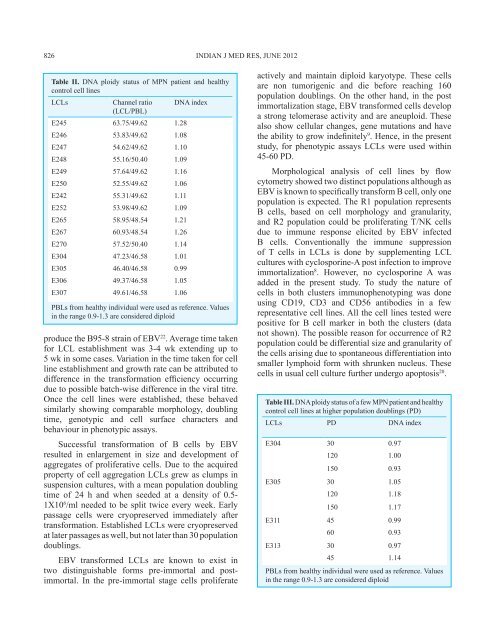LIFE09200604007 Tabish - Homi Bhabha National Institute
LIFE09200604007 Tabish - Homi Bhabha National Institute
LIFE09200604007 Tabish - Homi Bhabha National Institute
Create successful ePaper yourself
Turn your PDF publications into a flip-book with our unique Google optimized e-Paper software.
826 INDIAN J MED RES, JUNE 2012<br />
Table II. DNA ploidy status of MPN patient and healthy<br />
control cell lines<br />
LCLs<br />
Channel ratio<br />
(LCL/PBL)<br />
E245 63.75/49.62 1.28<br />
E246 53.83/49.62 1.08<br />
E247 54.62/49.62 1.10<br />
E248 55.16/50.40 1.09<br />
E249 57.64/49.62 1.16<br />
E250 52.55/49.62 1.06<br />
E242 55.31/49.62 1.11<br />
E252 53.98/49.62 1.09<br />
E265 58.95/48.54 1.21<br />
E267 60.93/48.54 1.26<br />
E270 57.52/50.40 1.14<br />
E304 47.23/46.58 1.01<br />
E305 46.40/46.58 0.99<br />
E306 49.37/46.58 1.05<br />
E307 49.61/46.58 1.06<br />
DNA index<br />
PBLs from healthy individual were used as reference. Values<br />
in the range 0.9-1.3 are considered diploid<br />
produce the B95-8 strain of EBV 22 . Average time taken<br />
for LCL establishment was 3-4 wk extending up to<br />
5 wk in some cases. Variation in the time taken for cell<br />
line establishment and growth rate can be attributed to<br />
difference in the transformation efficiency occurring<br />
due to possible batch-wise difference in the viral titre.<br />
Once the cell lines were established, these behaved<br />
similarly showing comparable morphology, doubling<br />
time, genotypic and cell surface characters and<br />
behaviour in phenotypic assays.<br />
Successful transformation of B cells by EBV<br />
resulted in enlargement in size and development of<br />
aggregates of proliferative cells. Due to the acquired<br />
property of cell aggregation LCLs grew as clumps in<br />
suspension cultures, with a mean population doubling<br />
time of 24 h and when seeded at a density of 0.5-<br />
1X10 6 /ml needed to be split twice every week. Early<br />
passage cells were cryopreserved immediately after<br />
transformation. Established LCLs were cryopreserved<br />
at later passages as well, but not later than 30 population<br />
doublings.<br />
EBV transformed LCLs are known to exist in<br />
two distinguishable forms pre-immortal and postimmortal.<br />
In the pre-immortal stage cells proliferate<br />
actively and maintain diploid karyotype. These cells<br />
are non tumorigenic and die before reaching 160<br />
population doublings. On the other hand, in the post<br />
immortalization stage, EBV transformed cells develop<br />
a strong telomerase activity and are aneuploid. These<br />
also show cellular changes, gene mutations and have<br />
the ability to grow indefinitely 9 . Hence, in the present<br />
study, for phenotypic assays LCLs were used within<br />
45-60 PD.<br />
Morphological analysis of cell lines by flow<br />
cytometry showed two distinct populations although as<br />
EBV is known to specifically transform B cell, only one<br />
population is expected. The R1 population represents<br />
B cells, based on cell morphology and granularity,<br />
and R2 population could be proliferating T/NK cells<br />
due to immune response elicited by EBV infected<br />
B cells. Conventionally the immune suppression<br />
of T cells in LCLs is done by supplementing LCL<br />
cultures with cyclosporine-A post infection to improve<br />
immortalization 8 . However, no cyclosporine A was<br />
added in the present study. To study the nature of<br />
cells in both clusters immunophenotyping was done<br />
using CD19, CD3 and CD56 antibodies in a few<br />
representative cell lines. All the cell lines tested were<br />
positive for B cell marker in both the clusters (data<br />
not shown). The possible reason for occurrence of R2<br />
population could be differential size and granularity of<br />
the cells arising due to spontaneous differentiation into<br />
smaller lymphoid form with shrunken nucleus. These<br />
cells in usual cell culture further undergo apoptosis 20 .<br />
Table III. DNA ploidy status of a few MPN patient and healthy<br />
control cell lines at higher population doublings (PD)<br />
LCLs PD DNA index<br />
E304 30 0.97<br />
120 1.00<br />
150 0.93<br />
E305 30 1.05<br />
120 1.18<br />
150 1.17<br />
E311 45 0.99<br />
60 0.93<br />
E313 30 0.97<br />
45 1.14<br />
PBLs from healthy individual were used as reference. Values<br />
in the range 0.9-1.3 are considered diploid

















